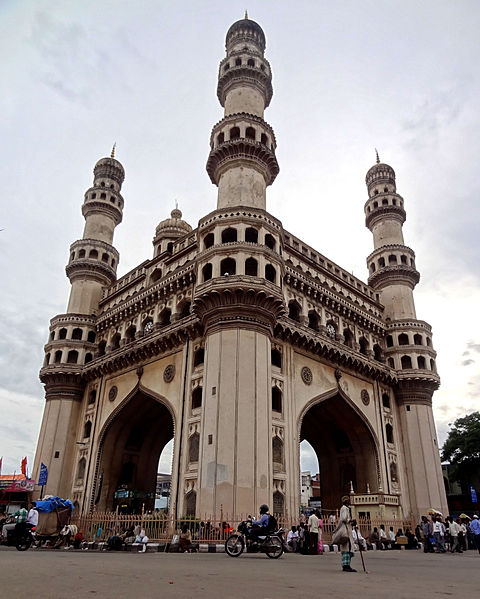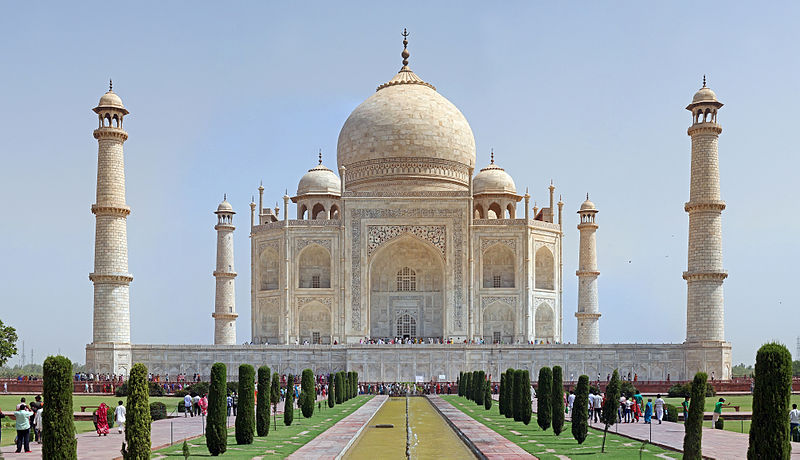Char Minar (Hyderabad)

Hyderabad is not an ancient city by Indian Standards. It was founded late in the 16th century. Its char Minar was built in 1591 to commemorate a fight against the plague that was ravaging the population, the handsome rectangular structure is basically a monumental gate at the crossroads of two important streets. Its four main arches and the corner of the base are placed exactly according to the four Cardinal points – east, west, north and south. Slender graceful minarets and rows of arches rise above the bazaar below.
Before Independence people were not allowed to climb the minarets. Because the two Palaces can be viewed from there and the Nizam did not want the lovely ladies of the royal household to be seen by strangers. Today Because of the unusual splendour of its architecture, it has been declared one of India’s protected monuments.
The Maharaja Palace (Mysore)
Mysore is a city of great splendour and its most impressive building is the Maharaja’s Palace. It is one of the largest in India and imagination has run wild in its decoration. The architectural outline is a synthesis of Indian and Persian styles with gateways, domes, arches, turrets, columns and sculpture in magnificent profusion.
The interior is a lavish melange of gilt and grandeur, bright colours, mirrors and glass. Hordes of tourists visit the Palace every day for there is much to see and admire, paintings, Murals, Silver thrones, crystal chair, Metal pillars. A golden howdah, and a golden umbrella which, according to legend, belonged to the Pandavas of the Mahabharata.
Sahelion-Ki-Bari (Udaipur)
Just beyond the embankment of the Fateh Sagar lake in Udaipur Lies a most fascinating garden. It was laid out for the Maids of Honour who had been sent to the Maharana as a peace offering by the Emperor from Delhi.Which is why the park is called Sahelion-Ki-Bari.
Flowers waver in the breeze. Fountains rise in plumes. Marble elephants spray water through their trunks. The pools are ornamented with finely sculpted “ Chhatri” of soft black stone. A white marble cupola, in the centre of one pool, creates a waterfall. On the roofs of black marble pavilions birds revolve in a circle of spray. Since 18th Century when the garden was erected it has continuously delighted visitors.
Taj Mahal (Agra)

The celebrated Taj Mahal is often numbered among the seven wonders of the world. The graceful lines of this magnificent marble mausoleum, the aesthetically perfect dome, the enchanting flower designs inlaid in precious stones, the filigreed screen, and the setting in an exquisitely laid garden, form a vision of elegance and ethereal beauty, especially when viewed by moonlight or at dawn, when the shimmering pale rays make the Taj Mahal appear to be moving.
This monument of love was ordered by Shah Jahan for his favourite wife, Mumtaz Mahal. The construction took twenty two years and unaccountable expenses. Shah Jahan was buried in this magnificent tomb beside his beautiful queen.
The River Beas (Punjab)
The river Beas was known to the ancient Greeks as Hyphasis. It is one of the five great rivers that gave Punjab its name. Its rises near the Rohtang Pass, high in the Himalayas, flows through forests of pine and deodar, accepting warm welcome from the flanking mountains, and finally joins the river Sutlej. On the way this mighty rushing river generates hydroelectric power for surrounding areas.
The sparkling water of Beas rages through a gorge from Manali to Kulu with rocky hillsides rising almost perpendicularly to more than 1,000 feet on either side. The river becomes more placid when it reaches the valley of the Gods and runs calmly through the ever changing beauty of flower- spangled meadows and fruit orchards in Himachal Pradesh. And then it continues to its final destination to the river Sutlej.
Harbour (Goa)
Planes and buses connect Goa to the rest of India, but the best way to get there is by boat, as the Portuguese did when they sailed down the Mandovi river in the 16th century and captured Old Goa.
In its earlier stages the river Slithers Lazily, past fertile fields and villages. Barges chug along it carrying iron ore to Marmagao Harbour. Before the river reaches the sea it flows through Panaji, the Capital city, where public buildings line the riverside boulevard and, further down the quayside feverish activity attends the arrival and departure of steamers from Mumbai and ferry boats that cross the river regularly, despite the bridges that now span the blue waterway.
Naga Dances

In former times Naga Tribesmen were associated with hunting and warlike activities. Today they are a proud people, highly organized and disciplined , who retain their dances and, to a great extent, their old lifestyles even in the 20th century.
Naga Dances are rhythmic, colorful, and incorporate many aspects of life. The characteristic feature is the erect posture, with crisp movements of the legs and comparatively little of the torso and arms. Ofen a rich variety of verbal sounds and cries complement the music. Dancers apply war-paint on bare bodies or wear fright hued costumes, resplendent head dresses, and armlets of stone, horn and brass.
Ladakh known for its tradition
The barrier formed by the Himalayas have ensured that the people of Ladakh could retain their traditions and way of life for centuries. It is a remote land of ascetic beauty, and many westerners consider it “ The Last Shangri-La”.
The people mostly of Tribeto-Chinese stock, are hardy hospitable and happy. Muslim women dress in heavy black robes. Buddhists, and they are in the majority, prefer the bright maroon and saffron colours of the monks and nuns. Girls and women wear long sleeved jackets over ankle-length skirts. Their painted hair, greased with butter, is covered with a scarf or the jaunty Ladakhi cap. Silver jewellery, studded with turquoise and coral, is the main adornment, and heightens their natural beauty and charming smiles.
A trip to North Bengal’s Himalayas
The best seasons for visiting north Bengal Himalayas are April and May and from mid October till the end of January. A hiking trip from Darjeeling to Phalut (via Jorpokhri, Tanglu and Sandakphu) take eight to ten days.
In the summer the road runs through meadows of Apline flowers and glowing forests of conifer and deciduous trees in their pristine beauty, since this part of the Himalayas is off the normal trekking tracks. It is a bird lovers paradise with rare varieties.
People consider Sandakphu the most rewarding stop in winter. It is a small settlement on a ridge, 11930 feet above the sea level. One gets fantastic sights of snows, glaciers, Everest, Kanchenjunga , Makalu, Lhotse, and other peaks in Bhutan and Sikkim, from here.
Image from Wikipedia